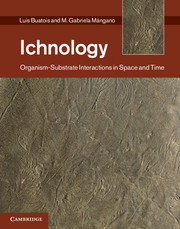Book contents
- Frontmatter
- Contents
- Acknowledgments
- Introduction
- Part I Conceptual tools and methods
- Part II Spatial trends
- 6 Trace fossils and paleoecology
- 7 Ichnology of shallow-marine clastic environments
- 8 Ichnology of marginal-marine environments
- 9 Ichnology of deep-marine clastic environments
- 10 Ichnology of continental environments
- 11 Ichnology of carbonate environments, rocky shorelines, and volcanic terrains
- Part III A matter of time
- References
- Index
7 - Ichnology of shallow-marine clastic environments
from Part II - Spatial trends
Published online by Cambridge University Press: 25 October 2011
- Frontmatter
- Contents
- Acknowledgments
- Introduction
- Part I Conceptual tools and methods
- Part II Spatial trends
- 6 Trace fossils and paleoecology
- 7 Ichnology of shallow-marine clastic environments
- 8 Ichnology of marginal-marine environments
- 9 Ichnology of deep-marine clastic environments
- 10 Ichnology of continental environments
- 11 Ichnology of carbonate environments, rocky shorelines, and volcanic terrains
- Part III A matter of time
- References
- Index
Summary
As discussed in other chapters of this book, traces commonly receive a paleontologic or zoologic connotation. Because of this aspect, traces are often given a short shrift by sedimentologists. This situation is unfortunate, and indeed unfair, to the study of sediments because the contained lebensspuren are sedimentary structures (albeit biologically formed) and should receive attention equal to that devoted to structures developed by physical processes. In fact, these traces often supply evidence of sedimentological conditions that is superior to information gained only by the study of physical structures. If the foregoing is not sufficient reason for sedimentologists to be concerned with the study of ichnology, perhaps they can be prodded into it by virtue of the fact that the nefarious beasts creating the biogenic structures have a nasty habit of destroying their beloved physical structures, and they should at least attempt to identify the enemy!
Jim Howard “The sedimentological significance of trace fossils” (1975)Historically, one of the major strengths of ichnology is its utility in facies analysis and paleoenvironmental reconstructions. Undoubtedly, marine ichnology has been the main focus of most trace-fossil research in this respect. However, our knowledge of marine ichnofaunas is still uneven. The vast majority of ichnological studies applied to facies analysis and paleoenvironmental reconstruction deals with ichnofaunas from siliciclastic successions, rather than carbonates, mixed carbonates-clastics, or volcaniclastics. In siliciclastic settings, both shallow- and deep-marine ichnofaunas have received similar attention. However, ichnological studies in shallow-marine environments have attained better integration with sedimentological data than those in deep-marine settings. In turn, the ichnology of wave-dominated shallow-marine environments has been explored in more detail than their tide-dominated counterparts. In connection with this, the ichnological content of sandy shores is much better known than that of muddy coasts. In fact, some specific types of muddy shorelines, such as chenier plains (e.g. Augustinus, 1989), remain essentially unrecognized in the geological record. Also, end members, with respect to wave and tidal dominance, are better understood than mixed systems (e.g. Anthony and Orford, 2002). In this chapter, we will review the ichnology of different shallow-marine clastic environments, covering wave-dominated, tide-dominated, mixed systems, and muddy shorelines.
- Type
- Chapter
- Information
- IchnologyOrganism-Substrate Interactions in Space and Time, pp. 126 - 151Publisher: Cambridge University PressPrint publication year: 2011



